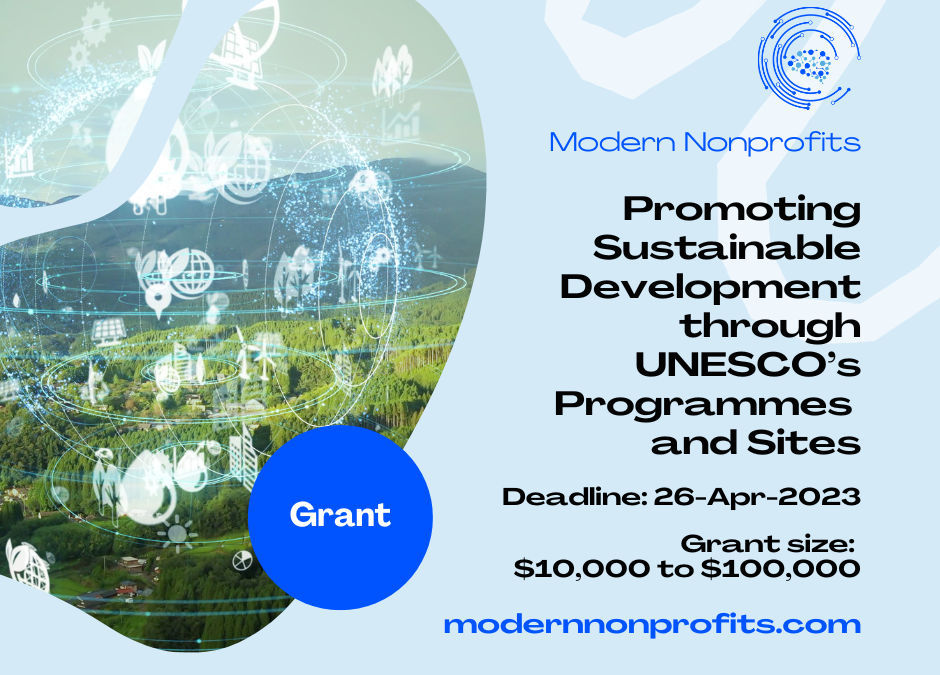Call for Applications: Promoting Sustainable Development through UNESCO’s Programmes and Sites
Deadline Date: 26-Apr-2023
Donor Name: United Nations Educational, Scientific and Cultural Organization(UNESCO)
Grant Size: $10,000 to $100,000
Category: Grants
Focus Countries: Albania, Andorra, Antigua and Barbuda, Armenia, Austria, Azerbaijan, Bahamas, Barbados, Belarus, Belgium, Belize, Bosnia And Herzegovina, Bulgaria, Canada, Costa Rica, Croatia, Cuba, Cyprus, Czech Republic, Denmark, Dominica, Dominican Republic, El Salvador, Estonia, Finland, France, Georgia, Germany, Greece, Grenada, Guatemala, Haiti, Holy See (Vatican City State), Honduras, Hungary, Iceland, Ireland, Italy, Jamaica, Latvia, Liechtenstein, Lithuania, Luxembourg, Macedonia, Malta, Mexico, Moldova Republic Of, Monaco, Netherlands, Nicaragua, Norway, Panama, Poland, Portugal, Romania, Saint Kitts And Nevis, Saint Lucia, Saint Vincent And The Grenadines, San Marino, Slovak Republic, Slovenia, Spain, Sweden, Switzerland, Trinidad And Tobago, Ukraine, United Kingdom, United States, Montenegro, Kosovo
More Info
The UNESCO Regional Bureau for Science and Culture in Europe and the abrdn Charitable Foundation (aCF) are launching a second call for applications to UNESCO designated sites in Europe and North America, as a part of the 3-year project ‘Promoting sustainable development through UNESCO’s programmes and sites’.
UNESCO and the abrdn Charitable Foundation (aCF) launched in March 2022 a 3-year partnership to promote sustainability through research and education with the goal of developing innovative solutions relating to the environment, water and the ocean.
As part of the partnership between UNESCO and the aCF, the project Promoting sustainable development through UNESCO’s programmes and sites seeks to promote a more sustainable and climate neutral Europe by working through UNESCO designated sites to act as pilot sites for sustainable development and the implementation of the Sustainable Development Goals, notably SDGs 6 (Clean water and sanitation), 13 (Climate action), 14 (Life below water) and 15 (Life on land).
UNESCO’s scientific programmes, the Man and the Biosphere Programme (MAB), the Intergovernmental Hydrological Programme (IHP), the International Geoscience and Geoparks Programme (IGGP) and the Intergovernmental Oceanographic Commission of UNESCO (IOC) and its networks will be mobilized in supporting and promoting the project.
Eligible Topics
- Biodiversity and Sustainability (MAB-related)
- Water (IHP-related)
- Earth Sciences (IGGP-related)
- Ocean (IOC-related)
- Climate Change and disasters (Crosscutting)
Eligible Sites
- Eligible UNESCO sites are Biosphere Reserves, Global Geoparks, and Natural and Mixed World Heritage sites.
- The project will work through a total of 15 sites in 3 years. Each year, UNESCO and the Advisory Board of the project will select 5 sites at the beginning of each one-year cycle. Each selected site will be expected to work on all 3 expected results and to focus on one topic throughout the project (for example, if the chosen topic is biodiversity, the site will implement research, education and innovative solutions dedicated to biodiversity).
- For this second year of the project, sites must be located in the Europe and North America region. Sites under the direct purview of the UNESCO Regional Bureau for Science and Culture in Europe will be prioritized. Multi-designated areas, i.e. areas having obtained more than one UNESCO designation will be considered favourably. Two sites (such as a Global Geopark and a Biosphere Reserve) that are situated in a same geographical area may also decide to submit a joint proposal.
- Each selected site will receive funding from the project to implement activities under the three expected results for a total amount of up to 25,000 USD per site.
- Sites will be working closely with UNESCO for the implementation of the three expected results on the ground. In particular, UNESCO will work with the selected sites to ensure the work proposed is linked closely to UNESCO priorities (notably MAB, IHP, IGGP and IOC) and is scalable at the regional and global levels. UNESCO will also work closely with the communities involved in the activities (for example with the schools).
- The 5 selected sites (per year) will have the opportunity to exchange and support each other throughout the 3-year project. Sites will be invited to present the results of their activities to UNESCO and the aCF as well as at international events organized by UNESCO.
Expected Results
The project will focus on 3 components/expected results:
- Expected result 1: promoting research applied and applicable in UNESCO designated sites related to SDGs 6, 13, 14 and 15 and MAB, IHP, IGGP and IOC priority areas, notably biodiversity and sustainability, geoscience, water, the ocean, the climate and disasters. Priority will be given to research scalable at ecosystem level, regionally and globally.
- Expected result 2: promoting and implementing Education for Sustainable Development, water education, climate change education or ocean literacy in UNESCO designated sites. Activities should be developed closely with upper primary/ lower secondary schools located in the site with the capacity to adapt and implement UNESCO guidelines/methodologies.
- Crosscutting Expected result 3: Innovative ‘green’ and ‘blue’ smart and technological solutions for sustainable development and climate change linked to Expected Result 1 developed with key stakeholders in the site, notably the private sector and the civil society (notably youth), scalable at ecosystem, regional and global level.
Selection Criteria
- Managing authorities of the eligible sites will need to submit an application in coordination with their MAB National Committee (if a biosphere reserve) IGGP national committees (if a Global Geopark) and/or their UNESCO National Commission (for all sites). Applications from multi-designated areas (or multiple sites) shall jointly submit the application. The proposed contractor needs to be an entity with legal personality and notably have an independent bank account, so that UNESCO can enter into contract with it.
- The application will be judged against the following criteria:
- Completeness of Application form duly filled, dated, stamped and signed by the relevant managing authority(ies).
- Proven capacity of the project proposed to achieve all the 3 expected results notably in relation to the chosen topic within a 12-month timeframe.
- For the research expected result, demonstrated cooperation with a university or a research centre situated within or very close to the site(s) with proven expertise in relation to the chosen research topic (for example an existing EU-funded project, a nationally funded project or a PhD or master’s thesis). Relation with a UNESCO Chair or Centre is an advantage.
- For the education expected result, previous cooperation with schools within or close to the site with experience working on sustainability, biodiversity, water, climate change or ocean literacy. Participation of UNESCO ASP net schools is an advantage.
- For the crosscutting innovation expected result, demonstrated cooperation with key stakeholders in the private sector or civil society (such as local administrations, NGOs, local businesses.) with capacity to carry out innovative projects related to the chosen topic. Involvement of youth groups is an advantage.
- Quality and relevance of the application and coherence between the 3 expected results.
- For the research expected result: scientific originality, use of scientific methodology, potential for development of new scientific knowledge, link to MAB/IHP/IGGP/IOC priority areas and SDGs 6, 13, 14 and 15, involvement of universities, research partners, and PhD students.
- For the education expected result: innovative approach to promote water/ESD/climate change education/ocean literacy, proposed use of existing UNESCO guidelines and tools such as ESD and ocean literacy toolkits, capacity of the education partners and schools to implement activities, link to research expected result and to MAB/IHP/IOC priority areas and SDGs 6, 13, 14 and 15.
- For the innovation crosscutting expected result: innovative proposal on green/blue smart and technological solutions, link to research and education components, identification of key stakeholders in the project, notably private sector, civil society and youth.
- Good balance of the activities between the 3 expected results.
- Properly-structured and detailed budget with itemized costs.
- Clear implementation plan.
- Scalability of the 3 expected results within UNESCO global networks.
- Demonstrated ecosystem value of the proposal (coastal/island/Mediterranean; mountain; forest; agriculture; river basin; hydrogeological resources, wetland/Ramsar, Natura2000).
- Demonstrated impacted climatic zone.
- Consideration of youth and gender dimensions in the proposal is an advantage.
- Involvement and engagement with UNESCO site stakeholders.
- Consideration of interdisciplinary approaches is an advantage.
- Geographical location (within Europe and North America, with priority to applicants from countries under the purview of the UNESCO Regional Bureau for Science and Culture in Europe).
For more information, visit UNESCO.
If you are interested in presenting your project, I can help you develop your project application and help you find partners. Book a meeting today.


